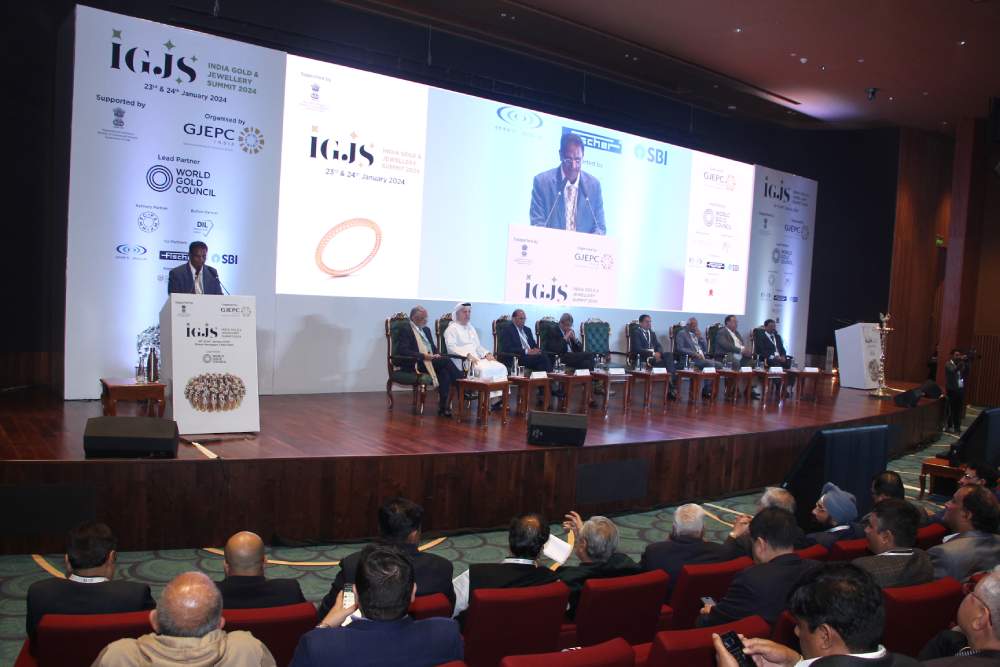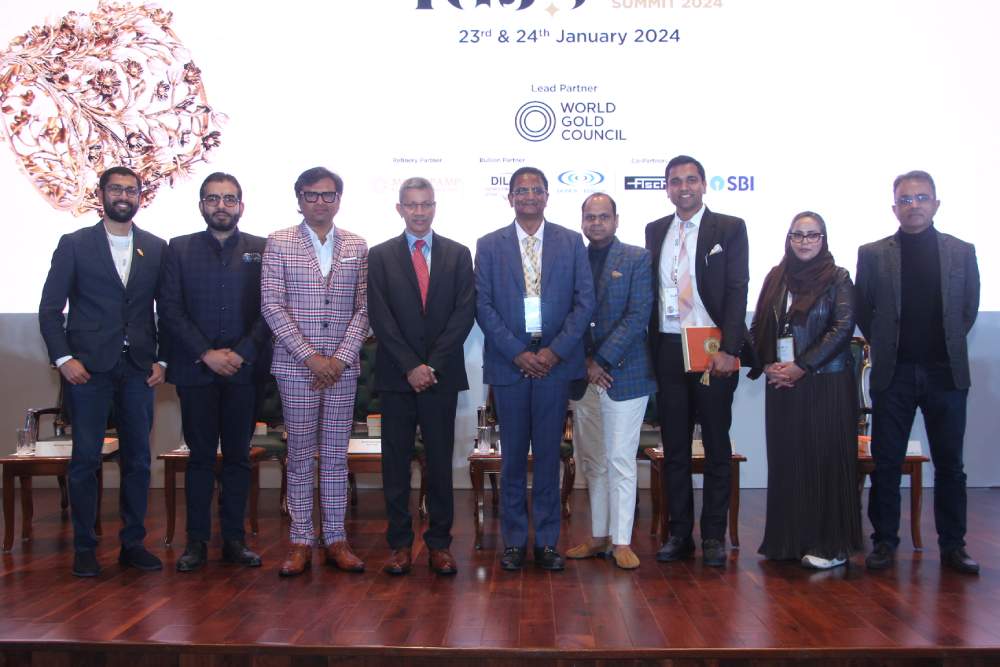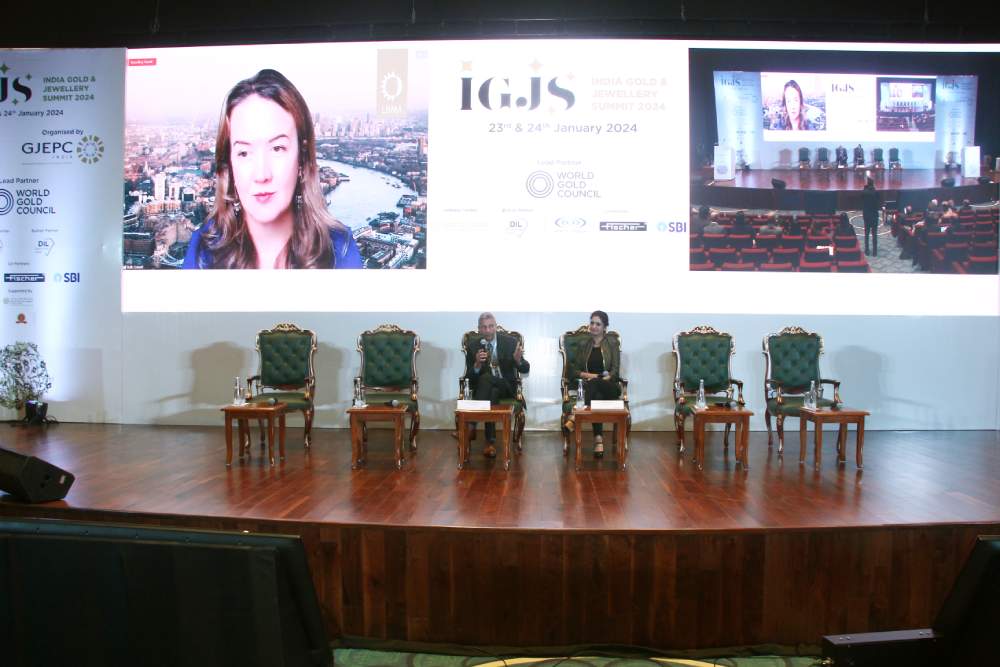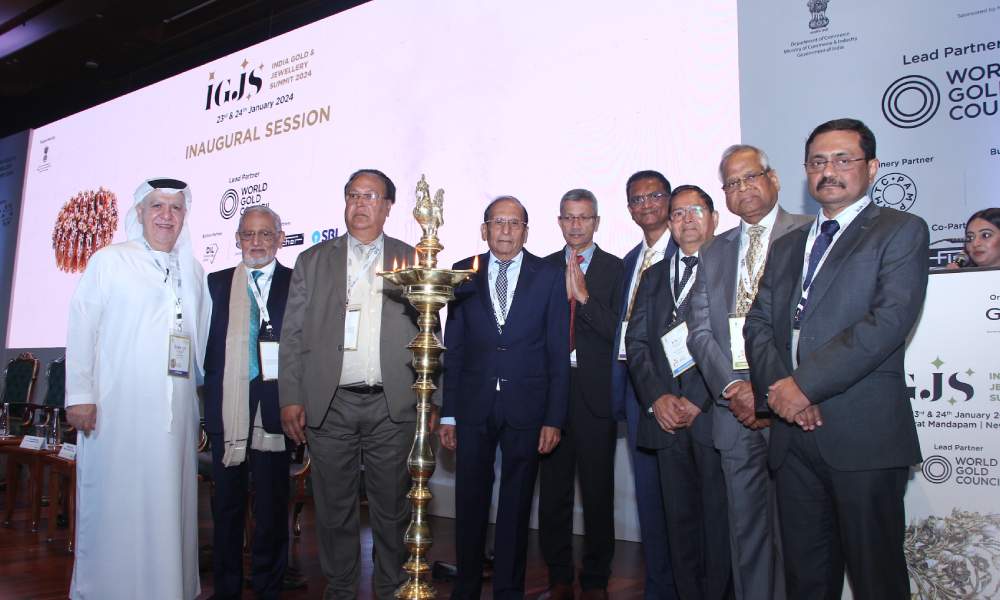The Gem & Jewellery Export Promotion Council (GJEPC) has concluded the 4th edition of the India Gold & Jewellery Summit (IGJS) that was held at Bharat Mandapam in New Delhi on 23rd-24th January 2024, with World Gold Council as the lead partner.
Held under the theme of “Raise Gold’s Role In Economic Growth”, the highly anticipated India Gold & Jewellery Summit (IGJS), the first since the Covid pandemic, prompted several stimulating conversations around India’s gold jewellery ecosystem, which stands strong in infrastructure, policies, exports, retail, design, and innovation, and is poised for a significant role on the global stage.
During his special address, Santosh Kumar Sarangi, Director General, Directorate General of Foreign Trade (DGFT), Union Ministry of Commerce & Industry, Govt. of India urged GJEPC to popularise Indian jewellery exports through e-commerce; and to position India as top supplier, design creator and value-adding hub for gold jewellery.
The two-day conference witnessed more than 350 delegates from across the gold supply chain interacting with key stakeholders, including senior officials from Union Ministry of Commerce & Industry and the Department of Commerce; market leaders like World Gold Council, London Bullion Market Association (LBMA); jewellery retailers; regulators; academia and other stakeholders to discuss the most critical challenges and opportunities facing the gold industry today.
Among the dignitaries that graced the event were Vipul Shah, Chairman, GJEPC; Somasundaram P.R., Regional CEO – India, World Gold Council; R. Arulanandan, Director, Department of Commerce, Union Ministry of Commerce & Industry, Govt. of India; Kirit Bhansali, Vice Chairman, GJEPC; and Dr. Nawal Kishore Agarwal, Convener, Jewellery Panel, GJEPC.
Arulanandan, Director, Department of Commerce, Union Ministry of Commerce & Industry, Govt. of India, said, India faces challenges as a consuming nation heavily reliant on imports, particularly of bullion and dore gold. The complexities of exporting 24-karat gold further add to our concerns, including regulatory issues. The collaboration between the World Gold Council and GJEPC, along with other stakeholders, is a positive step in prompting collective reflection. The Department of Commerce aims to leverage your insights to transform these thoughts into actionable solutions.”
In his speech, Vipul Shah, Chairman, GJEPC, said, “The India Gold & Jewellery Summit aims is to create a dialogue between the policy makers and the industry to help create policies for growth of trade and exports from India’s gem and jewellery sector. This year’s Summit is significant due to key policy initiatives taken by the Government such as signing of India UAE CEPA and India Australia ECTA; successful implementation of Hallmarking and HUID policy; a very successful review of India by FATF and a host of other initiatives. Talking about the future, we aim to reach a cumulative gem and jewellery export value of USD 75 billion by 2030. Specifically, we have set a target for gold jewellery alone to achieve USD 25 billion by 2030.

“The gold industry plays a significant role in shaping our economic landscape. India has made remarkable strides, creating a dynamic ecosystem with vast potential for growth. This includes jewellery manufacturing units, retailers, exporters, refiners, gold exchange, skill development institutes, and promotional bodies such as GJEPC, which showcase and create markets for India-made jewellery across the world,” said Shah.
Somasundaram PR, Regional CEO, India, World Gold Council (WGC), noted, “Gold has touched lifetime high prices even as interest rates are high and stock markets do not reflect any stress. Central banks bought over 1000 tonnes of gold last year and this trend continues at these high prices. India will see a huge rebound in gold demand as prosperity rises and as organized retail grows significantly. We have to be prepared for a strong rebound in Indian demand on the back of strong economic growth as incomes are the biggest influencer of demand in our context. We are in the final stages of forming a self-regulatory body soon for the industry with support from apex trade bodies such as GJEPC and other constituents.”
Vipul Shah added, “GJEPC recently launched an SOP book for the Gold Jewellery Industry, which sets out general compliances required to be undertaken by the gold jewellery industry from the perspective of Customs Law, Foreign Trade Policy; Goods and Services Tax, Income Tax and Hallmarking.”

Talking about the India-UAE CEPA, Shah pointed out, “The gold industry, especially, has been benefited by India-UAE CEPA which was championed by our Hon’ble Commerce Minister. To take full advantage of CEPA we have also set up India Jewellery Exposition Centre in Dubai. India’s exports of plain gold jewellery to UAE surged by 47% during April-November 2023.”
Santosh Kumar Sarangi, DG, DGFT, Union Ministry of Commerce & Industry, said, “India stands as one of the largest buyers of gold globally, showcasing considerable buying power that can potentially influence the streamlining of gold prices and availability. Recognising the fragmented nature of gold demand in India, spanning from small to large jewellers and varying from kilograms to tons, there’s a pressing need for streamlining exports. With immense potential, the aim should be to become the foremost exporter globally. Drawing a parallel with Switzerland, we need champions in India investing in creative designs catering to Western tastes.”
“Collaboration between the Department of Commerce, GJEPC, and leading brands is essential to formulate a robust branding strategy positioning India as a top supplier and value-added provider of gold jewellery”, said Mr. Sarangi.
Talking about e-commerce, Sarangi said, “The potential of e-commerce in cross-border transactions is vast, with estimates predicting a rise to $2 trillion by 2030. To encourage this platform, the consignment value for e-commerce exports is increased to Rs.10 lakh. GJEPC is urged to organise outreach programs in interior regions to facilitate understanding and adoption of e-commerce platforms.”
In 2022, the global exports of gold jewellery reached $113.19 billion, with India contributing significantly by accounting for $9.22 billion or 8.10% of this total. India secured its position as the 4th largest exporter of gold jewellery, following major players such as China, UAE and Switzerland.
IGJS 2024 explored how the Indian gold industry can best position itself to capitalise on emerging opportunities through a series of discussions. The inaugural day of the summit featured various sessions, including discussions on Leveraging the India-UAE Comprehensive Economic Partnership Agreement (CEPA) for Export Growth, Enhancing India’s Competitiveness Through Design & Innovation, and Ensuring the Secure Supply of Gold Through Digitisation.
Day two covered topics such as Promoting Compliance Through Responsible Reporting In India, Exploring the Sustainable Coexistence of Independent Stores And Organised Retail, and Raising Compliance Through Responsible Sourcing Globally.
KEY TAKEAWAYS
Leveraging the India-UAE Comprehensive Economic Partnership Agreement (CEPA) for Export Growth
Panellists:
Sabyasachi Ray, Executive Director, GJEPC
Tamjid Abdullah, Deputy CEO, Jawhara Jewellery
Konal Doshi, Partner, Modern Impex
Chirag Vora, Director, Bafleh
Samruddhi Zaveri, Haribhai Gems
Gaurav Pundir, Deputy Secretary, Department of Commerce, Ministry of Commerce & Industry

- The India-UAE Comprehensive Economic Partnership Agreement (CEPA) is hopeful to replicate the HK-China CEPA 2006 model and achieve more than the $100 billion target by 2030.
- There is an in principle agreement to designate IJEX Dubai as a designated zone to facilitate import for non-registered importers under temporary bond admission, enabling them to avail duty benefits.
- The Western world looking at India to source new tech-driven designs, and that IJEX Dubai acts as a great platform for supporting new-age business for Indian exporters and the Middle East countries.
- There is a compelling proposal to leverage the Tariff Rate Quota (TRQ) mechanism for receiving gold of defined fineness, allowing for the import of scrap gold. Collaborative efforts between UAE refineries and Indian retailers could streamline the process, enabling direct exchange of gold, thereby reducing transaction costs significantly.
- The expanding presence of major Indian retail stores in the Middle East further solidifies this strategic alliance. There is a call for enhanced cooperation between the two countries, not only in the exchange of jewellery designs but also in the fusion of design concepts.
- The last decade’s transformative changes in the gold industry are due to factors like mandatory hallmarking, FTA, UAE-CEPA, IIBX, and the smooth implementation of GST.
- The impact of the CEPA is evident in the positive double-digit growth in exports to Dubai.
- India’s competitive advantage lies in its cost-effectiveness, particularly when compared to regions like Italy. While an Italian handcrafted piece might triple in price when adding the artisan touch, Indian jewellery maintains a cost advantage with only a 4-5% wastage factor. This distinction positions India favourably in the global market, offering high-quality handcrafted jewellery at competitive prices.
- There is a need for a clear policy outline for the next 10 years, advocating for a self-regulatory organisation to demonstrate industry responsibility and ensure best practices.
- India faces challenges as a consuming nation heavily reliant on imports, particularly of bullion and dore gold. The complexities of exporting 24-karat gold further add to our concerns, including regulatory issues.
- The collaboration between the World Gold Council and GJEPC, along with other stakeholders, is a positive step in prompting collective reflection. The Department of Commerce aims to leverage the Summit’s insights to transform these thoughts into actionable solutions.
- Gems and jewellery account for around 57% of exports under CEPA’s preferential lines, and has shown a healthy growth of 43% from May to October 2023.
KEY TAKEAWAYS
Raise India’s Competitiveness Through Design & Innovation
Panellists:
Jitender Dabas, Chief Operating Officer, McCann Worldgroup India
Tanmay Shah, Director,2626 Creative Studio Pvt. Ltd.
Yash Agarwal, Birdhichand Ghanshyamdas
Abhishek Haritwal, Haritsons Designs
Prof. Alba Capellieri, Head of Jewelry & Accessories Design, Politecnico di Milano
Deepak Choksi, Director, CVM – Innovation in Manufacturing
Budoor Obaid, UAE Jewellery Designer
Abhishek Sand, Co-Founder & Director, Savio Jewellery
Shayak Mazumder, CEO & Founder, Adya

- India is at par in producing well-finished designer jewellery made by hand and high-tech machines.
- Technologies of today are playing a role at each stage of the value chain from Insights, Design, Realisation and Delivery
- From triggering insights to the design process and realisation, technology acts as a glue, transforming how businesses operate.
- Be more competitive and create more value in terms of functionality and emotions.
- Make effective use of design and innovation to offer more value to consumers.
- Build more trust in your brand through transparency, education and credibility.
- Build more meaning through personalising designs.
- Create better narratives and stories around your product.
- Adopt a fusion of handcraftsmanship with cutting-edge technology to meet the growing demand for unique and mass-produced pieces.
- The significance of design is at the core of success and there is a growing acceptance of unique pieces with gemstones, particularly uncut diamonds, in the market.
KEY TAKEAWAYS
Driving The New Age Business
Panellists:
Suvankar Sen, Managing Director, Senco Gold & Diamonds
Sachin Jain, Managing Director, De Beers India
Praveen Govindu, Partner, Deloitte India
Hiral Parikh, Minal Info Jewel

- The organised jewellery market is outperforming the overall market growth.
- In Europe, vintage/pre-owned jewellery is expected to grow as buyers look to differentiate.
- Product innovations such as 24-kt hard gold, and heritage gold have improved the inclination of Chinese Gen-Z to buy gold from 16% (2016) to 64% (2023).
- In the Middle East, personalised jewellery is set to gain traction.
- Gold demand driven in India due to Government policy support Hallmarking, GMS, export promotion schemes; omnichannel customer experience; rising income levels, and growing discretionary spending.
- The growth of an organisation has to be the growth of every stakeholder.
- De Beers is positive about the future sourcing of diamonds. The diamond business is expected to grow 2.5 times by 2030. The company aims to be more India-focused.
- De Beers focuses on the 4 Pillars of Brand, Source Transparency, Digital Everywhere, and Purpose.
- Train karigars to bring professionalism to the business.
- The Indian gem and jewellery industry has changed 180 degrees from where it was 10-15 years ago, with greater professionalism, organised stores and high-quality jewellery.
KEY TAKEAWAYS
Securing Supply of Gold / Digitisation of Gold
Panellists:
Prof. Sundaravalli Chair, India Gold Policy Centre, IIM Ahmedabad
Prakash Pincha, Managing Director, Jewel India Pvt. Ltd.
Nirakar Chand, CEO-Precious Metals, Diamond India Ltd.
Raj Bahadur Trivedi, General Manager, State Bank of India
Mahendran Krishnamurthy, Country Head – Precious Metals Division, The Karur Vysya Bank Ltd.
Vikas Singh, Managing Director & CEO, MMTC- PAMP India Pvt. Ltd.
Ashok Gautam, Managing Director & Chief Executive Officer, IIBX
Capt. Kapil Chaudhary, Joint Secretary (Drawback), Department of Revenue
Arulanandan, Director, Department of Commerce
Manisha Gupta, Editor, Commodities & Currencies, CNBC TV 18

- There’s an urgent need to secure the gold supply and digitize gold in the country to bring it into the formal economy.
- Despite challenges, there is optimism about improving the gold refining capacity and leveraging technologies to enhance schemes like the Gold Monetization Scheme (GMS).
- Banks can play a crucial role in facilitating the digitization and financialization of gold, and serve as critical channels for initiatives like the Sovereign Gold Bond Scheme.
- There’s a need for a regulatory framework for digital gold products.
- Gold is a borderless commodity and it is price-inelastic.
- Tax and duty drawback disparities (ad valorem versus specific) are affecting potential gold jewellery exports from India and must be addressed through immediate policy intervention within the legal framework. If solved, it could drive up gold exports 10x from India.
KEY TAKEAWAYS
Special Session
Speaker:
Rupa Dutta, Principal Economic Advisor, DPIIT

- The gems and jewellery sector currently contributes around 9% to India’s total merchandise exports, with a goal to increase this share to 14-16%.
- Employing 5 million people, the sector is a significant contributor to the nation’s economy, particularly with a focus on gold, which alone contributes around $9.4 billion to exports.
- India is recognised as one of the oldest and largest manufacturers of handmade gold jewellery, with a rich heritage in craftsmanship.
- India is the 4th largest exporter of gold, following major players such as China, UAE, and Switzerland. The industry aims to achieve total exports of $75 billion by 2030.
- The government has introduced several initiatives to support the sector, including mandatory hallmarking, increased duty drawback rates, and trade agreements like the India-UAE CEPA.
- Quality Control Orders have played a crucial role in boosting exports and reducing imports, emphasizing the importance of maintaining high standards.
- The establishment of facilities like the IJEX in Dubai, the Bharat Ratnam Mega CFC in SEEPZ, Mumbai, and the upcoming Jewellery Park in Navi Mumbai signifies the government’s commitment to providing end-to-end solutions and creating employment opportunities.
- Global exports of gold jewellery reached $113 billion, with India contributing 8-9%. The sector is expected to witness further growth with upcoming FTAs like UK, Europe, GCC, and more.
- There’s a need to explore ways to monetize gold, including popularizing the Sovereign Gold Bond scheme, introducing gold-backed financial products, and integrating the One District One Product (ODOP) scheme with Geographical Indication (GI) trademarks.
- Leveraging e-commerce platforms, including the establishment of the IIBX, is crucial for the sector’s growth.
- As India aims for a $32 trillion economy by 2047, the gems and jewellery industry must focus on moving up the value chain, embracing innovation, and ensuring quality control to thrive in the global market.
KEY TAKEAWAYS
SPECIAL INTERACTIVE SESSION
Speaker:
Santosh Kumar Sarangi, Director General, DGFT, Ministry of Commerce & Industry, Govt. of India

- India stands as one of the largest buyers of gold globally, showcasing considerable buying power that can potentially influence the streamlining of gold prices and availability.
- Recognising the fragmented nature of gold demand in India, spanning from small to large jewellers and varying from kilograms to tons, there’s a pressing need for streamlining.
- India currently holds the position of the 4th largest exporter. With immense potential, the aim should be to become the foremost exporter globally.
- Drawing a parallel with Switzerland, we need champions in India investing in creative designs catering to Western tastes.
- Collaboration between the Department of Commerce, GJEPC, and leading brands is essential to formulate a robust branding strategy positioning India as a top supplier and value-added provider of gold jewellery.
- Challenges related to ICR rules, tariff rate quotas, and other obstacles will be addressed in tandem with the gems and jewellery division in DoC.
- Integration of CAD, CAM, and AI for design creation, sourcing, and virtual presentation to customers is essential for future growth.
- GJEPC urged to take the lead in creating a virtual exhibition centre to showcase new designs in a three-dimensional environment, thereby supporting small and medium-level jewellers, and securing international purchase orders.
- The potential of e-commerce in cross-border transactions is vast, with estimates predicting a rise to $2 trillion by 2030. To encourage this platform, the consignment value for e-commerce exports is increased to Rs.10,00,000.
- GJEPC urged to organise outreach programs in interior regions to facilitate understanding and adoption of e-commerce platforms.
KEY TAKEAWAYS
Raising Compliance Through Responsible Reporting In India
Panellists:
Kaushal Sampat, Founder, Rubix Data Sciences Pvt. Ltd
Ananth Radhakrishan, Director, Customs
Pramod Agarwal, Chairman, National Gems & Jewellery Council of India (NGJCI)
Supreme Kothari, Partner, Economic Laws Practice

- The My KYC initiative by GJEPC focuses on validating the identity of council members globally. The platform verifies various details and is a permanent ID on the platform, accessible to authorised entities for verification. Though the process is a one-time exercise, it requires annual validation.
- It is vital to balance compliance and trade promotion policies with measures to prevent abuse and revenue leakage. There is a need for a harmonious reading of multiple legislations, and challenges arise due to different interpretations.
- For gems and jewellery, a separate group (3A) has been created for the faceless assessment of sensitive commodities like diamonds.
- Efforts are being made for partial recredit in the electronic bond and bank guarantee system.
- The industry, through NGJCI, has shown a high threshold of compliance, and this should build trust. Financial Action Task Force (FATF) was astonished to see India’s implementation of HUID under mandatory hallmarking of gold jewellery.
- Integration of SEZ with Customs and Icegate is a work in progress, and is expected to enhance trade facilitation.
KEY TAKEAWAYS
Independent Store & Organised Retail – A Sustainable Coexistence
Panellists:
Neelesh Hundekari, Senior Partner & Global Head – Gems and Jewellery Practice, and APAC Head – Fashion & Luxury Practice, Kearney
Raghav Rastogi, Jugal Kishore Jewellers
Atul Jain, Atul Jewellers
Varghese Alukka, Managing Director, Jos Alukkas Group
Anil Sankhwal, Convener, Studded Jewellery Committee, GJEPC
Manisha Gupta, Editor, Commodities & Currencies, CNBC TV 18

- India is the third largest fine jewellery market; Highest share of GDP and is over-indexed on gold. And, India has shown a strong growth rate ahead of other peers like China and the US.
- The market size of the Indian fine jewellery market, in 2023 is Rs. 4.5 Lakh crore, and is expected to grow in double digits by 2030.
- In India, the Branded Jewellery market represented a ~35% share and is expected to reach ~40% by 2027.
- Top players in the branded segment are expected to grow in the range of 15-18% in 2024; expansion to spill further from metros to tier-1, and tier-2 cities; Rising e-commerce salience in the industry with branded players omnichannel offerings and the emergence of DTC players.
- Globally, branded jewellery is taking market share from unbranded jewellery, a trend that appears secular and to continue in the medium term.
- Retail jewellery chain players are directing their focus from modern contemporary to traditional styles as well, as women increasingly embrace aesthetic collections and inclusivity.
- Independents have started to pivot their focus from core traditional to modern contemporary featuring diamond and gemstone portfolios.
- Independent jewellers’ focus on key imperatives will lead to the co-existence of both in the highly competitive landscape if they adopt transparency, digital payments and marketing, personalisation, customisation, retain core customers, and leverage basic data insights to map purchase history as well as focus on high-margin-coloured gemstones.
- Customer loyalty is very flimsy, and consumers are willing to explore all their options. First-time buyers feel big chains offer a sense of safety and security.
KEY TAKEAWAYS
Raising Compliance Through Responsible Sourcing Globally
Panellists:
Somasundaram, Regional CEO, India, World Gold Council
Ruth Crowell, CEO, LBMA
Manisha Gupta, Commodities Editor, CNBC TV 18

- India still engaged with issues like taxes and is focused on arbitrages. It’s not making responsible sourcing of gold a priority.
- India the most important market for gold. The country is now taking its rightful seat at the table.
- LBMA is committed to ensuring continuous improvement of Responsible Sourcing business practices and to supporting supply chains that are free from threat financing.
- LBMA’s new sustainable strategy revolves around: Improvement of LBMA oversight of audits; Increasing the share of responsible ASM gold in the market; Trust and integrity across the full value chain among others.
- Artisanal gold commitment remains a key strategic priority and is engaging the world.
- The beauty of policymaking in India lies in its collateral benefits. Initiative like IIBX is not just about trading volumes; but it acts as a catalyst for disciplined thinking, especially in sectors like gold. The collateral benefits, a unique hallmark of Indian policymaking, unfold organically, steering the nation towards holistic development.
- Need for a focused stand on gold reforms for the next 5 years. This can ensure that India’s strides in digital finance are seamlessly integrated into the gold industry, encouraging growth and global prominence.
- Investors are increasingly interested not only in profitability but also in ensuring that their investments align with ethical and sustainable practices that will offer a competitive edge.

